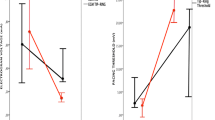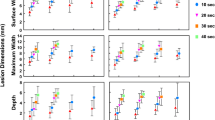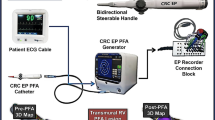Abstract
Background
Creation of linear lesions using multielectrode catheters may be effective at treating cardiac arrhythmias.
Objective
We compared unipolar versus bipolar ablation, evaluated the effects of varying effective electrode areas, and compared single electrode versus multielectrode temperature control during multielectrode radiofrequency ablation.
Methods
Intramural radiofrequency ablation was performed on five greyhounds at thoracotomy, from an epicardial approach using a 0.8 mm diameter bipolar electrode needle. Fifteen left ventricular ablations were performed per animal. Intramural ablation was performed to maintain a constant electrode–tissue interface. The distal and proximal electrodes measured 1.5 and 1.0 mm in length respectively with an interelectrode distance of 4 mm. Radiofrequency energy was applied to both electrodes simultaneously for 60 s using a target temperature of 80°C. During bipolar ablation, the temperature was regulated from either the distal (BPA1.5) or proximal (BPA1.0) electrode only. During unipolar ablation (UPA), the temperature at both electrodes were simultaneously controlled. Lesions were assessed histologically.
Results
During UPA, consistent target temperatures were achieved at both electrodes. In comparison to UPA, the temperature at both electrodes were significantly decreased during BPA1.0. During BPA1.5 a significant (p < 0.001) temperature increase (94.7 ± 2.1°C) was observed at the 1.0 mm electrode. BPA1.0 resulted in reduced (p = 0.008) lesion width at the 1.5 mm electrode and no change in lesion depth (p = 0.064) at both electrodes compared to UPA. Conversely, lesion dimensions increase significantly at both electrodes during BPA1.5.
Conclusion
Unipolar multielectrode ablation with simultaneous temperature control at both electrodes is more predictable and hence likely to be safer than bipolar ablation.
Similar content being viewed by others
References
Kovoor, P., Daly, M., Pouliopoulos, J., Dewsnap, M. B., Eipper, V., & Ross, D. L. (2005). Effect of inter-electrode distance on bipolar intramural radiofrequency ablation. Pacing and Clinical Electrophysiology, 28(6), 514–520, Jun.
McRury, I. D., & Haines, D. E. (1998). Efficacy of multiple ring and coil electrode radiofrequency ablation catheters for the creation of long linear lesions in the atria. Medical Engineering & Physics, 20(8), 551–557 (Nov).
Panescu, D., Fleischman, S. D., Whayne, J. G., Swanson, D. K., Mirotznik, M. S., McRury. I., et al. (1999). Radiofrequency multielectrode catheter ablation in the atrium. Physics in Medicine and Biology, 44(4), 899–915 (Apr).
Roithinger, F. X., Steiner, P. R., Goseki, Y., Liese, K. S., Scholtz, D. B., Sippensgroenewegen, A., et al. (1999). Low-power radiofrequency application and intracardiac echocardiography for creation of continuous left atrial linear lesions. Journal of Cardiovascular Electrophysiology, 10(5), 680–691 (May).
Su, W. W., Johnson, S. B., Jain, M. K., Hall, J., & Packer, D. L. (2005). Creating continuous linear lesions in the atria: A comparison of the multipolar ablation technique versus the conventional drag-and-burn. Journal of Cardiovascular Electrophysiology, 16(8), 905–911 (Aug).
Zheng, X., Walcott, G. P., Rollins, D. L., Hall, J. A., Smith, W. M., Kay, G. N., et al. (2001). Comparison of the temperature profile and pathological effect at unipolar, bipolar and phased radiofrequency current configurations. Journal of Interventional Cardiology and Electrophysiology, 5(4), 401–410 (Dec).
Chang, R. J., Stevenson, W. G., Saxon, L. A., & Parker, J. (1993). Increasing catheter ablation lesion size by simultaneous application of radiofrequency current to two adjacent sites. American Heart Journal, 125(5 Pt 1), 1276–1284 (May).
Tungjitkusolmun, S., Haemmerich, D., Cao, H., Tsai, J. Z., Choy, Y. B., Vorperian, V. R., et al. (2002). Modeling bipolar phase-shifted multielectrode catheter ablation. IEEE Transactions on Biomedical Engineering, 49(1), 10–17 (Jan).
Thiagalingam, A., Pouliopoulos, J., Barry, M. A., Boyd, A. C., Eipper, V., Yung, T., et al. (2005). Cooled needle catheter ablation creates deeper and wider lesions than irrigated tip catheter ablation. Journal of Cardiovascular Electrophysiology, 16(5), 508–515 (May).
Nath, S., DiMarco, J. P., & Haines, D. E. (1994). Basic aspects of radiofrequency catheter ablation. Journal of Cardiovascular Electrophysiology, 5(10), 863–876 (Oct).
Haemmerich, D., Staelin, S. T., Tungjitkusolmun, S., Lee, F. T., Jr., Mahvi, D. M., & Webster, J. G. (2001). Hepatic bipolar radio-frequency ablation between separated multiprong electrodes. IEEE Transactions on Biomedical Engineering, 48(10), 1145–1152 (Oct).
Haines, D. E., & Verow, A. F. (1990). Observations on electrode–tissue interface temperature and effect on electrical impedance during radiofrequency ablation of ventricular myocardium. Circulation, 82(3), 1034–1038 (Sep).
Langberg, J. J., Calkins, H., el-Atassi, R., Borganelli, M., Leon, A., Kalbfleisch, S. J., et al. (1992). Temperature monitoring during radiofrequency catheter ablation of accessory pathways. Circulation, 86(5), 1469–1474 (Nov).
Kovoor, P., Daly, M., Campbell, C., Dewsnap, B., Eipper, V., Uther, J., et al. (2004). Intramural radiofrequency ablation: Effects of electrode temperature and length. Pacing and Clinical Electrophysiology, 27(6 Pt 1), 719–725 (Jun).
Bhavaraju, N. C., & Valvano, J. C. (1999). Thermophysical properties of swine myocardium. International Journal of Thermophysics, 20(2), 665–676.
Strohbehn, J. W. (1983). Temperature distributions from interstitial rf electrode hyperthermia systems: Theoretical predictions. International Journal of Radiation Oncology, Biology, Physics, 9(11), 1655–1667 (Nov).
Thiagalingam, A., Pouliopoulos, J., Barry, M. A., Salisbury, E., Pathmanathan, N., Boyd, A., et al. (2005). A thermochromic dispersive electrode can measure the underlying skin temperature and prevent burns during radiofrequency ablation. Journal of Cardiovascular Electrophysiology, 16(7), 781–788 (Jul).
Nath, S., Lynch, C., 3rd, Whayne, J. G., & Haines, D. E. (1993). Cellular electrophysiological effects of hyperthermia on isolated guinea pig papillary muscle. Implications for catheter ablation. Circulation, 88(4 Pt 1), 1826–1831 (Oct).
Author information
Authors and Affiliations
Corresponding author
Rights and permissions
About this article
Cite this article
Kovoor, P., Daly, M., Pouliopoulos, J. et al. Comparison of unipolar versus bipolar ablation and single electrode control versus simultaneous multielectrode temperature control. J Interv Card Electrophysiol 19, 85–93 (2007). https://doi.org/10.1007/s10840-007-9146-5
Received:
Accepted:
Published:
Issue Date:
DOI: https://doi.org/10.1007/s10840-007-9146-5




